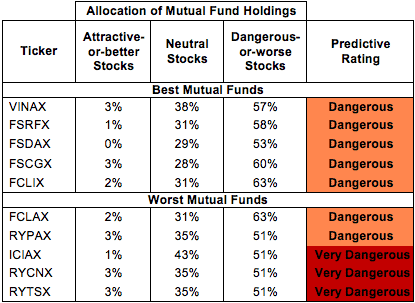Check out my sector overview on Reuters Insider here.
The Industrials sector ranks fifth out of the ten sectors as detailed in my Sector Rankings for ETFs and Mutual Funds report. It gets my Dangerous rating, which is based on aggregation of ratings of 17 ETFs and 18 mutual funds in the Industrials sector as of January 16, 2014. Prior reports on the best & worst ETFs and mutual funds in every sector are here.
Figures 1 and 2 show the five best and worst-rated ETFs and mutual funds in the sector. Not all Industrials sector ETFs and mutual funds are created the same. The number of holdings varies widely (from 20 to 357), which creates drastically different investment implications and ratings. The best ETFs and mutual funds allocate more value to Attractive-or-better-rated stocks than the worst ETFs and mutual funds, which allocate too much value to Neutral-or-worse-rated stocks.
To identify the best and avoid the worst ETFs and mutual funds within the Industrials sector, investors need a predictive rating based on (1) stocks ratings of the holdings and (2) the all-in expenses of each ETF and mutual fund. Investors need not rely on backward-looking ratings. My fund rating methodology is detailed here.
Investors should not buy any Industrials ETFs or mutual funds because none get an Attractive-or-better rating. If you must have exposure to this sector, you should buy a basket of Attractive-or-better rated stocks and avoid paying undeserved fund fees. Active management has a long history of not paying off.
Get my ratings on all ETFs and mutual funds in this sector on my free mutual fund and ETF screener.
Figure 1: ETFs with the Best & Worst Ratings – Top 5

Sources: New Constructs, LLC and company filings
Four ETFs are excluded from Figure 1 because their total net assets (TNA) are below $100 million and do not meet our liquidity standards.
Figure 2: Mutual Funds with the Best & Worst Ratings – Top 5

Sources: New Constructs, LLC and company filings
ICON Industrials Fund (ICTRX) and ICON Industrials Fund (ICICX) are excluded from Figure 2 because their total net assets (TNA) are below $100 million and do not meet our liquidity standards.
State Street SPDR Industrial Select Sector SPDR (XLI) is my top-rated Industrials ETF and Vanguard World Funds: Vanguard Industrials Index Fund (VINAX) is my top-rated Industrials mutual fund. Both earn my Dangerous rating.
Market Vectors Environmental Services ETF (EVX) is my worst-rated Industrials ETF and Rydex Series Funds: Transportation Fund (RYTSX) is my worst-rated Industrials mutual fund. EVX earns my Dangerous rating and RYTSX earns my Very Dangerous rating.
Figure 3 shows that 23 out of the 468 stocks (over 4% of the market value) in Industrials ETFs and mutual funds get an Attractive-or-better rating. However, 0 out of 17 Industrials ETFs and 0 out of 18 Industrials mutual funds get an Attractive-or-better rating.
The takeaways are: mutual fund managers allocate too much capital to low-quality stocks and Industrials ETFs hold poor quality stocks.
Figure 3: Industrials Sector Landscape For ETFs, Mutual Funds & Stocks
As detailed in “Cheap Funds Dupe Investors”, the fund industry offers many cheap funds but very few funds with high-quality stocks, or with what I call good portfolio management.
Investors need to tread carefully when considering Industrials ETFs and mutual funds, as there are no ETFs or mutual funds that earn my Attractive-or-better rating. Investors seeking exposure to the Industrials sector should focus on individual stocks instead.
Aircastle (AYR) is one of my favorite stocks held by Industrials ETFs and mutual funds and earns my Attractive rating. AYR has grown after-tax profit (NOPAT) by 25% compounded annually over the past six years. AYR’s 6% return on invested capital (ROIC) is not incredible, but it has slowly grown from 5% in 2010 and was enough to earn AYR positive economic earnings in 2012. The larger appeal of AYR, however, lies in its cheap valuation. At ~$19/share, AYR has a price to economic book value ratio of just 0.8, which implies a permanent 20% decline in NOPAT. AYR has a solid track record of profit growth and should surpass the market’s pessimistic expectations.
Sterling Construction Co, Inc. (STRL) is one of my least favorite stocks held by Industrials ETFs and mutual funds and earns my Very Dangerous rating. STRL has decreased NOPAT by 4% compounded annually over the last seven years while earning a bottom quintile ROIC of 3%. STRL has also generated negative economic earnings the past three years. Despite its struggles, promises of a potential turnaround have kept STRL overvalued. Its current valuation of ~$11/share implies 15% compounded annual growth in NOPAT for 13 years. That would be quite the turnaround. STRL is priced for the best-case scenario while significant risk remains to investors if it fails hit the high hurdles already embedded in its stock price.
410 stocks of the 3000+ I cover are classified as Industrials stocks.
Figures 4 and 5 show the rating landscape of all Industrials ETFs and mutual funds.
My Sector Rankings for ETFs and Mutual Funds report ranks all sectors and highlights those that offer the best investments.
Figure 4: Separating the Best ETFs From the Worst ETFs
Figure 5: Separating the Best Mutual Funds From the Worst Mutual Funds
Review my full list of ratings and rankings along with reports on all 17 ETFs and 18 mutual funds in the Industrials sector.
Kyle Guske II contributed to this report.
Disclosure: David Trainer and Kyle Guske II receive no compensation to write about any specific stock, sector or theme.



